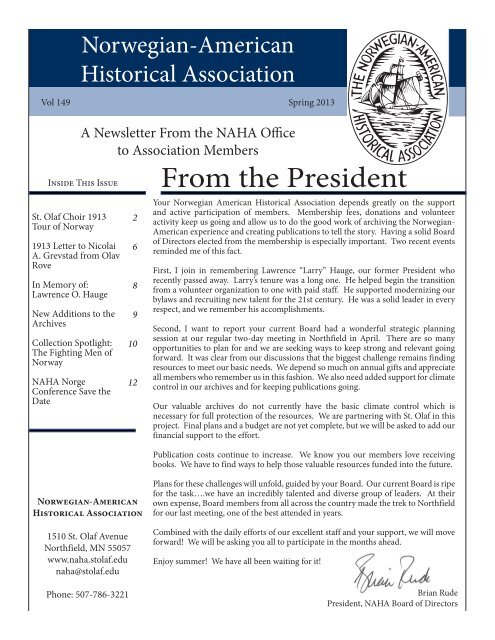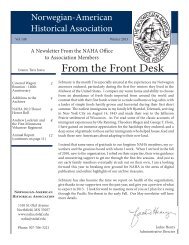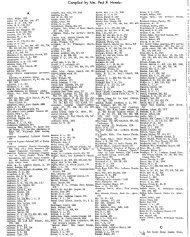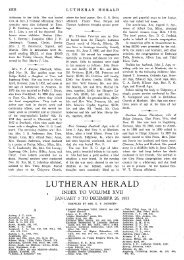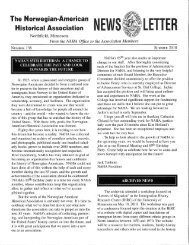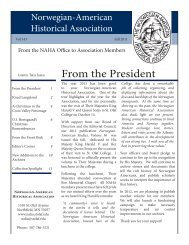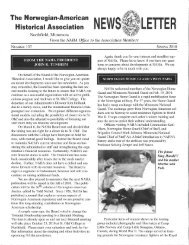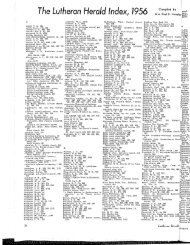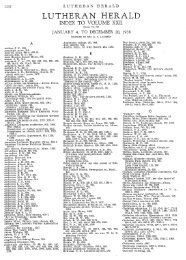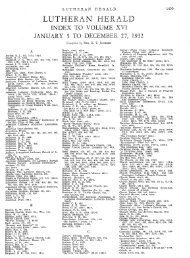Spring 2013 - Norwegian-American Historical Association - St. Olaf ...
Spring 2013 - Norwegian-American Historical Association - St. Olaf ...
Spring 2013 - Norwegian-American Historical Association - St. Olaf ...
You also want an ePaper? Increase the reach of your titles
YUMPU automatically turns print PDFs into web optimized ePapers that Google loves.
<strong>Norwegian</strong>-<strong>American</strong><br />
<strong>Historical</strong> <strong>Association</strong><br />
Vol 149 <strong>Spring</strong> <strong>2013</strong><br />
A Newsletter From the NAHA Office<br />
to <strong>Association</strong> Members<br />
Inside This Issue<br />
<strong>St</strong>. <strong>Olaf</strong> Choir 1913<br />
Tour of Norway<br />
1913 Letter to Nicolai<br />
A. Grevstad from Olav<br />
Rove<br />
In Memory of:<br />
Lawrence O. Hauge<br />
New Additions to the<br />
Archives<br />
Collection Spotlight:<br />
The Fighting Men of<br />
Norway<br />
NAHA Norge<br />
Conference Save the<br />
Date<br />
2<br />
6<br />
8<br />
9<br />
10<br />
12<br />
From the President<br />
Your <strong>Norwegian</strong> <strong>American</strong> <strong>Historical</strong> <strong>Association</strong> depends greatly on the support<br />
and active participation of members. Membership fees, donations and volunteer<br />
activity keep us going and allow us to do the good work of archiving the <strong>Norwegian</strong>-<br />
<strong>American</strong> experience and creating publications to tell the story. Having a solid Board<br />
of Directors elected from the membership is especially important. Two recent events<br />
reminded me of this fact.<br />
First, I join in remembering Lawrence “Larry” Hauge, our former President who<br />
recently passed away. Larry’s tenure was a long one. He helped begin the transition<br />
from a volunteer organization to one with paid staff. He supported modernizing our<br />
bylaws and recruiting new talent for the 21st century. He was a solid leader in every<br />
respect, and we remember his accomplishments.<br />
Second, I want to report your current Board had a wonderful strategic planning<br />
session at our regular two-day meeting in Northfield in April. There are so many<br />
opportunities to plan for and we are seeking ways to keep strong and relevant going<br />
forward. It was clear from our discussions that the biggest challenge remains finding<br />
resources to meet our basic needs. We depend so much on annual gifts and appreciate<br />
all members who remember us in this fashion. We also need added support for climate<br />
control in our archives and for keeping publications going.<br />
Our valuable archives do not currently have the basic climate control which is<br />
necessary for full protection of the resources. We are partnering with <strong>St</strong>. <strong>Olaf</strong> in this<br />
project. Final plans and a budget are not yet complete, but we will be asked to add our<br />
financial support to the effort.<br />
Publication costs continue to increase. We know you our members love receiving<br />
books. We have to find ways to help those valuable resources funded into the future.<br />
<strong>Norwegian</strong>-<strong>American</strong><br />
<strong>Historical</strong> <strong>Association</strong><br />
1510 <strong>St</strong>. <strong>Olaf</strong> Avenue<br />
Northfield, MN 55057<br />
www.naha.stolaf.edu<br />
naha@stolaf.edu<br />
Phone: 507-786-3221<br />
Plans for these challenges will unfold, guided by your Board. Our current Board is ripe<br />
for the task….we have an incredibly talented and diverse group of leaders. At their<br />
own expense, Board members from all across the country made the trek to Northfield<br />
for our last meeting, one of the best attended in years.<br />
Combined with the daily efforts of our excellent staff and your support, we will move<br />
forward! We will be asking you all to participate in the months ahead.<br />
Enjoy summer! We have all been waiting for it!<br />
Brian Rude<br />
President, NAHA Board of Directors
Page 2<br />
The <strong>St</strong>. <strong>Olaf</strong> Choir Tours Norway<br />
The following is an<br />
excerpt taken from The<br />
<strong>St</strong>. <strong>Olaf</strong> Choir, A Narrative<br />
(1997) by NAHA member<br />
Joseph M. Shaw, emeritus<br />
professor of history, <strong>St</strong>.<br />
<strong>Olaf</strong> College. Used with<br />
permission of the author.<br />
In June <strong>2013</strong>, the <strong>St</strong>. <strong>Olaf</strong><br />
Choir will embark on its<br />
100th anniversary tour of<br />
Norway. See the enclosed<br />
brochure for dates and<br />
locations.<br />
The Choir’s visit to the Fargo<br />
church convention in June of 1912<br />
yielded an important contact that<br />
opened the way for the 1913 tour<br />
to Norway. The idea of a Choir<br />
trip to the motherland must have<br />
been on the minds of [F. Melius]<br />
Christiansen and [P.G.] Schmidt<br />
ever since the Band tour to Norway<br />
of 1906. Manager Paul Schmidt<br />
took up the possibility with two<br />
<strong>Norwegian</strong> church leaders who<br />
predicted a favorable reception for<br />
the Choir in Norway. Plans were<br />
drawn up, eleven guarantors were<br />
secured, and a <strong>St</strong>. <strong>Olaf</strong> faculty<br />
member, J. Jørgen Thompson, was<br />
sent to Norway in March of 1913<br />
to make specific arrangements. 53<br />
The Viking article on the Choir’s<br />
Norway tour began as follows: “On<br />
Friday, June 13, 1913, the <strong>St</strong>. <strong>Olaf</strong><br />
Choir left Northfield on its extended<br />
tour to Norway, not with any fear<br />
of ill omen which superstition may<br />
have attached to this particular date,<br />
but with the most joyful anticipation<br />
of a sea voyage and of a visit to that<br />
country of beauty and freshness<br />
which has been described to us from<br />
our earliest childhood.” 54<br />
The Choir invited the pastor of<br />
<strong>St</strong>. John’s Church, the Reverend<br />
T. H. Haugan, to make the trip to<br />
Norway with them and to serve<br />
as their spokesman at receptions,<br />
banquets, and other occasions. 55<br />
It was a happy choice, for Pastor<br />
Haugan admirably fulfilled his role.<br />
P.G. Schmidt wrote of him, “He was<br />
an exceptionally fluent speaker in<br />
<strong>Norwegian</strong> and on many occasions<br />
the audience was charmed both by<br />
his winning personality and by the<br />
fine presentation of his message. 56<br />
There were concerts on the way<br />
in <strong>St</strong>. Paul, in Wisconsin, and<br />
Brooklyn, New York. On June 24th<br />
the Choir sailed from New York for<br />
Norway on the “Christianiafjord.”<br />
It reached Bergen, Norway on<br />
July 4th and gave the first concert.<br />
Afterwards a banquet was given for<br />
the Choir in the Grand Hotel by<br />
the Anglo-<strong>American</strong> Club. When<br />
Pastor Haugen was introduced,<br />
he expressed thanks on behalf of<br />
<strong>St</strong>. <strong>Olaf</strong> College for the wonderful<br />
reception and won the warm esteem<br />
of his listeners when he said:<br />
We knew that Norway’s heart<br />
was big and warm but not as<br />
big and warm as we have seen<br />
and experienced it. We, of<br />
course, also realize that mother<br />
Norway looks with regret on<br />
the many folks that have left<br />
her shores to establish homes<br />
across the sea. But I want to<br />
assure you, my friends, that<br />
we cherish all that we have<br />
received from our mother<br />
country. We will preserve this<br />
priceless treasure, our heritage,<br />
and we will endeavor to make it<br />
felt in the community life of the<br />
great country on the other side<br />
of the Atlantic. To come back<br />
to Norway for many of us is like<br />
coming home. 57<br />
From Bergen the ship took the<br />
Choir along the coast with stops at<br />
<strong>St</strong>avanager and Kristiansand on the<br />
way to the capital city, Christiania,<br />
later called Oslo. “Our most hearty<br />
welcome was felt when we sailed<br />
into port at Christiania where<br />
thousands of people awaited our<br />
coming and three hundred voices<br />
sang out their songs of good cheer<br />
and brotherhood,” wrote K.E. ’16 in<br />
the Viking summary of the tour. 58<br />
The welcome for the Choir was<br />
genuine enough, but the size and<br />
enthusiasm of the crowd was also<br />
related to the fact that the ocean<br />
liner “Christianiafjord” was the<br />
first ship of the recently established<br />
<strong>Norwegian</strong>-America steamship line<br />
and on this occasion was completing<br />
its first voyage from America to<br />
Norway. 59<br />
King Haakon and Queen Maude<br />
attended the concert at the<br />
University of Aula in Christiania.<br />
Special care was given to having the<br />
Choir in place on the platform at
Page 3<br />
100 Years Ago, June 1913 by Joseph M. Shaw<br />
8:00 p.m. Choir member Ida Haugen<br />
described the arrival of the royal<br />
pair: “They walked leisurely up to<br />
their places and we sang ‘Gud sign<br />
vor konge god,’ (‘God bless our good<br />
king’), everybody standing until<br />
we were through and the king and<br />
queen were seated. Our concert was<br />
a success, the king and queen smiled<br />
their thanks and shook hands with<br />
Prof. Christiansen, a thing which<br />
the Christiania people say the royal<br />
pair have never done before.” 60<br />
The itinerary plan followed by<br />
the Choir was to travel by train<br />
from Christiania northward to<br />
Trondheim and from there take<br />
the coastal boat “Lyra” southward<br />
along the coast and into some of<br />
the fjords, giving concerts along<br />
the way in coastal towns and cities.<br />
They would leave the “Lyra” at<br />
Larvik, the town in which F. Melius<br />
Christiansen grew up, and return by<br />
train to Christiania. 61<br />
On the way to Trondheim, the<br />
group stopped at Lillehammer for a<br />
boat trip on Lake Mjösa and a visit<br />
to Maihaugen, the outdoor museum<br />
located on a hill above the city. In<br />
Trondheim the Choir sang two<br />
concerts in the Nidaros Cathedral<br />
and visited the grave of Bernt Julius<br />
Muus, founder of <strong>St</strong>. <strong>Olaf</strong> College.<br />
A wreath was laid at the grave,<br />
which is near the Cathedral, and the<br />
Choir sang Christiansen’s “Som sol<br />
gaar ned i havet” (“As sinks the sun<br />
at even”). Following the first concert<br />
in Trondheim, a review in one of the<br />
city’s papers had these observations<br />
among others:<br />
Aboard ship - from left to right<br />
F.M. Christiansen, J.Jörgen Thompson, Paul G. Schmidt<br />
1913 <strong>St</strong>. <strong>Olaf</strong> Choir Tour to Norway<br />
The renditions were exceedingly<br />
beautiful, perfect in all their<br />
nuances, and the singing was<br />
stamped with the surety which<br />
only long and skilled instruction<br />
could give. The program was<br />
very beautiful and contained<br />
some things not hitherto sung<br />
here. Grieg’s “Hvad est du dog<br />
skjøn” was splendidly sung,<br />
likewise “Lover den Herre” and<br />
Söderman’s “Hør os Herre.” It<br />
was a great delight to hear “Deilig<br />
er Jorden’”; and Conradi’s “Alone<br />
with Thee” was given with much<br />
intensity and warmth. 62<br />
The reviewers reference to “Deilig<br />
er Jorden” (“Beautiful Savior”)<br />
would indicate that it was an<br />
optional number since it does not<br />
appear in the printed program.<br />
The Söderman piece was actually a<br />
song cycle of three numbers sung<br />
in Latin. In addition to the Grieg,<br />
“Lover den Herre” (“Praise to the<br />
Lord”), and “Deilig er Jorden,” the<br />
program offered only two more<br />
numbers sung in <strong>Norwegian</strong>, “Der<br />
Ringes paa jord” and “Moderens<br />
Sang” (“The Mother’s Song”),<br />
both by F. Melius Christiansen.<br />
Other numbers were “O Bread of<br />
Life” by Heinrich Isaac, “I Know<br />
That My Redeemer Liveth” from<br />
Messiah, and “Wake, Awake<br />
for Night is Flying” by Philipp<br />
Nicolai. A Ladies’ Quartette<br />
sang two numbers: the first was<br />
not identified; the second was<br />
Christiansen’s “The Lord is Full of<br />
Compassion”. 63<br />
The arrangement of traveling<br />
along the <strong>Norwegian</strong> coast on<br />
board the “Lyra” provided both<br />
transportation and a comfortable<br />
home for the Choir for two busy<br />
but enjoyable weeks of concerts<br />
and sightseeing. 64 The review<br />
in the town of <strong>St</strong>enkjaer found<br />
the singing of “Deilig er Jorden”<br />
(“Beautiful Savior”) to be “of<br />
overwhelming effect.” A writer<br />
Continued on page 4
Page 4<br />
for Kristiansund’s Posten reported<br />
that the hearers were enthralled.<br />
We heard singing as never<br />
before—singing that was so<br />
complete in dynamic shading<br />
and with delivery so sincere<br />
and moving, that as the tones<br />
died away we were left in a<br />
state of wonderment that a<br />
choir could attain so great<br />
a skill in the art of singing.<br />
And such discipline! It was<br />
a great experience merely to<br />
watch the conductor’s baton,<br />
to see how he controlled the<br />
50-voice choir. 65<br />
Aboard the “Lyra” all was peaceful<br />
and quiet between stops. The<br />
coastal towns were relatively close<br />
together so the ship moved at a<br />
leisurely pace. But the atmosphere<br />
changed each morning as it<br />
approached the landing pier.<br />
The captain detonated small<br />
bombs in the water announcing<br />
the Choir’s arrival. Tremendous<br />
crowds gathered. There were<br />
welcoming speeches, banquets<br />
and receptions. Some concert<br />
sites were much too small to hold<br />
the crowds.<br />
In Haugesund, where this was<br />
the case, an unusual impromptu<br />
performance took place for an<br />
enormous gathering of over<br />
10,000 people who were unable to<br />
get tickets for the concerts. They<br />
gathered in an open square down<br />
by the wharf where the “Lyra”<br />
was moored and stood silently, as<br />
only a <strong>Norwegian</strong> crowd can do,<br />
hoping for a glimpse of the Choir<br />
1913 <strong>St</strong>. <strong>Olaf</strong> Choir Tour<br />
members who had returned to the<br />
boat after the concert. P.G. Schmidt<br />
depicts the scene:<br />
Finally, a temporary director’s<br />
stand was set up on the boat’s<br />
forward deck, the choir<br />
members were called from<br />
their state rooms, and in the<br />
midnight stillness the choir<br />
began to sing to the heart of<br />
all these people some of the<br />
hymns and melodies known to<br />
them all, but sung as I am sure<br />
they had never heard them<br />
sung before. To be privileged to<br />
take part in the singing of those<br />
half-dozen songs under such<br />
circumstances was a thrill never<br />
to be forgotten. 66<br />
The genial “P.G.” was not one to<br />
forget the hilarious episodes either.<br />
The Choir often had to sing in<br />
churches in which, so it seemed to<br />
them, the windows had not been<br />
opened for decades. In such a<br />
church in southwestern Norway<br />
they removed a rear window for<br />
much-needed ventilation and<br />
proceeded with the concert. After a<br />
couple of numbers, Choir members<br />
heard the bleating of some goats far<br />
up the mountain behind the church.<br />
First it was a faint “baa, baa.” The<br />
Choir continued with its singing,<br />
louder passages, then softer ones.<br />
The goats were listening and coming<br />
nearer, and their “baa, baa” was<br />
getting louder. By now they were<br />
halfway down the mountain. Choir<br />
and director were struggling to<br />
keep from laughing, but managed,<br />
recalled P.G.<br />
Again the choir sang loud, this<br />
time the last number before<br />
intermission, and when we<br />
finished, the goats, that had<br />
now come all the way down<br />
were gathered just outside the<br />
window which we had removed,<br />
giving a veritable concert of<br />
their own. Their intonation<br />
was something to hear. During<br />
the intermission choir boys in<br />
evening dress could be seen<br />
chasing these pesky critters up<br />
the mountain and that too was<br />
quite an attraction. 67<br />
Norway’s spectacular scenery drew<br />
appreciative responses as the Choir<br />
proceeded up to fjord country. “We<br />
shall always remember the beautiful<br />
morning up Geirangerfjord, how we<br />
watched the over-hanging mist clear<br />
away and reveal to our eager sight<br />
the towering peaks and the snowclad<br />
mountain tops. Winding in and<br />
out through the irregular course<br />
of this fjord we would at times<br />
seem hemmed in on all sides when<br />
gradually there would appear some<br />
opening for escape,” wrote one of the<br />
students, recalling the experience. 68<br />
The Choir’s visit to Larvik was<br />
of particular interest because F.<br />
Melius Christiansen had lived there<br />
from age seven to seventeen and<br />
there received his start as a young<br />
musician. At the banquet given<br />
in the Larvik Grand Hotel he paid<br />
tribute to his organ teacher, Oscar<br />
Hansen. The concert in the Larvik<br />
church convinced a reviewer that<br />
reports about the Choir’s singing<br />
elsewhere in Norway were not<br />
overstated. “It is probable that
Page 5<br />
continued<br />
Norway had never heard singing<br />
nearly as fine as theirs….With the<br />
very first song the audience was<br />
completely won. Christiansen’s own<br />
beautiful and splendidly arranged<br />
numbers held the public, which,<br />
with every nerve tense, listened<br />
to the great waves of tone that the<br />
conductor secured from the choir.” 69<br />
The <strong>St</strong>. <strong>Olaf</strong> Choir gave further<br />
concerts in Christiania, Eidsvold,<br />
and in southern Norway. Its final<br />
day in Norway was August 3rd,<br />
the birthday of King Haakon. The<br />
Choir sent a telegraph to the king<br />
congratulating him on his birthday<br />
and thanking him for the kindnesses<br />
it had been shown everywhere<br />
in Norway. The king replied in<br />
a telegraph addressed to Paul G.<br />
Schmidt: “I thank the <strong>Norwegian</strong>-<br />
<strong>American</strong> singers for their good<br />
wishes and wish them a happy<br />
voyage home.” 70 The final concerts<br />
were presented at churches in<br />
Gothenburg and Malmö in Sweden,<br />
and in the City Hall in Copenhagen,<br />
Denmark. The return to the United<br />
<strong>St</strong>ates was made aboard the S.S.<br />
“Hellig Olav” which arrived in New<br />
York on August 18, 1913. 71<br />
Notes:<br />
53. Eugene E. Simpson, A History<br />
of <strong>St</strong>. <strong>Olaf</strong> Choir (Minneapolis:<br />
Augsburg Publishing House,<br />
1921), 83. Leola Nelson<br />
Bergmann, Music Master of<br />
the Middle West: The <strong>St</strong>ory of<br />
F. Melius Christiansen and the<br />
<strong>St</strong>. <strong>Olaf</strong> Choir (Minneapolis:<br />
University of Minnesota Press,<br />
1944), 119. Paul G. Schmidt,<br />
My Years at <strong>St</strong>. <strong>Olaf</strong>, A<br />
Centennial Decade Publication<br />
(Northfield, Minnesota: <strong>St</strong>.<br />
<strong>Olaf</strong> College [1967]), 57.<br />
54. The Viking ’16, ’17, ’18<br />
(Northfield, Minn.), 219<br />
55. Minutes of <strong>St</strong>. John’s Lutheran<br />
Church, Entry 116, May 20,<br />
1913.<br />
56. Schmidt, 61.<br />
57. Ibid.<br />
58. Viking ’16, ’17, ’18, 220.<br />
59. Schmidt, 59.<br />
60. Ida Hagen, “From the<br />
<strong>St</strong>. <strong>Olaf</strong> Choir Trip,” The<br />
United Lutheran, letter from<br />
Haugesund, Norway, July 23,<br />
1913. Cf. Bergmann, 120.<br />
61. Viking ’16, ’17, ’18, 221.<br />
62. Simpson, 102-103.<br />
63. 1913 European Choir Tour<br />
Program.<br />
64. Schmidt, 60-61.<br />
65. Cited in Simpson, 104.<br />
66. Schmidt, 62.<br />
67. Ibid., 63.<br />
68. Viking ’16, ’17, ’18, 221.<br />
69. Simpson, 107<br />
70. Ibid., 115<br />
71. Viking ’16, ’17, ’18, 223.<br />
Photos are from the <strong>St</strong>. <strong>Olaf</strong><br />
College Archives and used with<br />
their permission.<br />
Several <strong>St</strong>. <strong>Olaf</strong> Choir members at Lillehammer in 1913
Page 6<br />
Milwaukee, Wisconsin<br />
May 13, 1913<br />
Hon. Nicolai Grevstad,<br />
U.S. Minister, Montevideo<br />
Uraguay<br />
My dear Mr. Grevstad:<br />
Archive Highlight -<br />
Nikolai Grevstad during his<br />
term as Minister to Uruguay<br />
-Photo from the NAHA<br />
Collection<br />
From NAHA Collection P0533,<br />
The Nicolai Andreasen Grevstad<br />
Correspondence Collection<br />
In 1913, The Honorable Nikolai<br />
Grevstad served as U.S. Minister to<br />
Uraguay. Born in More og Romsdal<br />
and educated at the University<br />
of Christiania (Oslo), Grevstad<br />
served as editor of the Dagbladet in<br />
Norway from 1880 to 1883. Shortly<br />
thereafter he emigrated to the<br />
United <strong>St</strong>ates and took a position as<br />
editor of the Nordvesten, in <strong>St</strong>. Paul,<br />
Minnesota. Politically active in the<br />
Republican Party, Grevstad received<br />
an appointment as Ambassador to<br />
Paraguay and Uraguay from 1911<br />
to 1914. The <strong>Norwegian</strong>-<strong>American</strong><br />
<strong>Historical</strong> <strong>Association</strong> received his<br />
papers sometime between 1959 and<br />
1965, including correspondence from<br />
the period when he served in the<br />
Foreign Service.<br />
Gravsted received the following letter<br />
from Olav I. Rove, Vice Counsel for<br />
Norway in Wisconsin.<br />
Your kind favor of March 21st has been duly received<br />
and I thank you for the stamps which you enclosed.<br />
I shall appreciate it very much if you will kindly<br />
continue to send me stamps from the two countries<br />
to which you are accredited. If you care for any<br />
of the duplicates that I have I shall be very glad<br />
to furnish you some if you will kindly let me know.<br />
Now, in strict confidence I may tell you that the<br />
paper to which I referred in my former letter was<br />
Nye Norge, published by Mr. Franklin Peterson of<br />
Brooklyn. Since I wrote you he skipped the paper<br />
one week and then came out with one number and<br />
then stopped about three weeks. Now I understand<br />
that he has formed a kind of corporation but I<br />
know that the capital is not at all sufficient to<br />
keep the paper going. As a matter of fact I think<br />
that the new lease on life is acquired through the<br />
total abstainers of Brooklyn, who are arranging a<br />
17th of May celebration in opposition to the one<br />
arranged by the <strong>Norwegian</strong> National League, which<br />
League the paper has continually been fighting. I<br />
believe that Mr. Peterson is a man of considerable<br />
literary ability but in his editorials he has<br />
always been antagonistic to the existing regime<br />
in Brooklyn, but his antagonism has been expressed<br />
in such a manner that it has created a great deal<br />
of unpleasantness, and I imagine his subscription<br />
list has dwindled considerably.<br />
Nordisk Tidende has improved greatly under Mr. Rygg<br />
but as yet is only a local paper. I do not know<br />
whether he tries to make the paper on the style of<br />
Skandinaven as it was in your day. Mr. Peterson’s<br />
paper usually gets here Monday but as yet I have<br />
not received it.
Page 7<br />
100 Years Ago this Month<br />
Mrs. Jenny de Besche, wife of Dr. Johan de Besche<br />
of this city, died May 1st after an operation for<br />
appendicitis. Her death came rather suddenly and<br />
was entirely unexpected in our little colony. As<br />
a matter of fact most of them did not know that she<br />
had been taken to the hospital. Dr. de Besche<br />
has made up his mind that as soon as he can get<br />
his affairs arranged he will leave for Norway and<br />
settle down in that country. He expects to leave<br />
about the middle of July.<br />
We had a visit here from Mr. C.J. Hambro, the<br />
secretary of “Nordmansforbundet”. He comes as<br />
the representative of that society and also for<br />
the purpose of interesting the <strong>Norwegian</strong>s in this<br />
country in the exposition in Christiania next year.<br />
He has been very enthusiastically received all<br />
through the northwest and this is not, as is often<br />
the case, newspaper talk, but genuine enthusiasm<br />
and I believe his work will result in a great deal<br />
of good.<br />
Of course you know that North Dakota has appropriated<br />
$10,000 to send a delegation to represent the<br />
state at Christiania next year. A similar bill<br />
appropriating $15,000 is now before the legislature<br />
of this state and the chances for its adoption are<br />
very good. The bill introduced in the Minnesota<br />
legislature appropriating $25,000 was defeated by<br />
a small margin in the house, although it passed<br />
the senate, but in strict confidence I will tell<br />
you that I have private information that a bill<br />
will again be introduced in the extra session which<br />
is to be held next fall and the bill will then<br />
undoubtedly be passed.<br />
A biography of <strong>Olaf</strong> I. Rove can be<br />
found in History of Milwaukee, City<br />
and County, Vol. 3. He was born in<br />
Fredrikshald, Norway on 15 April,<br />
1864 to Severin and Azora Rove. He<br />
emigrated from Norway in 1884, first<br />
to New York City, and later moved to<br />
Madison, Wisc. where he attended<br />
the University of Wisconson,<br />
earning a law degree in 1890. Rove<br />
worked for the Norwestern Mutual<br />
Life Insurance Company. In 1906,<br />
he was appointed vice consul for<br />
Norway and received the Order of<br />
<strong>St</strong>. <strong>Olaf</strong> in 1912 in recognition of<br />
his work in the consular service. In<br />
1914, during a four-year term as<br />
president of the Sons of Norway,<br />
he traveled to Norway to represent<br />
the <strong>Norwegian</strong>s of the United <strong>St</strong>ates<br />
at the one hundredth anniversary<br />
of the adoption of the <strong>Norwegian</strong><br />
Constitution.<br />
Olav I. Rove is the adoptive greatgrandfather<br />
of political advisor and<br />
strategist, Karl Rove.<br />
What a pleasure it must be to be a man to go in and<br />
buy matches for $10, cigars for $50, etc. I would<br />
really like to have the experience for once, that<br />
is, provided either that I have money to spend so<br />
that I would not miss it, or else that dollars were<br />
not any larger than they are in your country.<br />
With kindest regards, I am,
Page 8<br />
In Memory of Lawrence O. Hauge, 1922-<strong>2013</strong><br />
Lawrence O. Hauge<br />
NAHA President 1981-2002<br />
Lawrence O. Hauge joined the<br />
<strong>Norwegian</strong>-<strong>American</strong> <strong>Historical</strong><br />
<strong>Association</strong> in 1978. He was<br />
elected to the board of directors<br />
in November 1980 at about<br />
the same time that Odd Lovoll<br />
began his tenure as editor of the<br />
<strong>Association</strong>. In less than one year,<br />
on September 26, 1981 Lawrence<br />
agreed to serve as president<br />
of the organization, a position<br />
which he held for 21 years until<br />
retiring from the board in April<br />
2002. Lawrence and his wife Lois<br />
would graciously host gatherings<br />
launching the many publications<br />
which debuted during his tenure<br />
as president.<br />
Brian Rude, current NAHA<br />
President recalls, “Larry was the<br />
consummate gentleman who<br />
cared deeply about promoting<br />
<strong>Norwegian</strong> heritage. He was a joy<br />
to work with -- always positive, fair<br />
to all, selfless. He guided NAHA<br />
successfully for two decades and<br />
helped lay the foundation for our<br />
future successes.”<br />
Lawrence Olav Hauge was born<br />
in Minneapolis, Minnesota on<br />
May 28, 1922 to Ole I. and Laura<br />
Solheim Flekke Hauge. Educated<br />
in the Minneapolis school system<br />
he earned a degree from the<br />
University of Minnesota School of<br />
Mortuary Science in 1947. He also<br />
attended the Minnesota School of<br />
Banking at <strong>St</strong>. <strong>Olaf</strong> College and<br />
attended the U.S. Army Officers<br />
School in Ft. Custer, Michigan.<br />
For many years, Lawrence practiced<br />
mortuary science in Minnesota and<br />
Wisconsin, owning and operating<br />
funeral homes in Minneapolis,<br />
<strong>St</strong>. Paul, <strong>St</strong>illwater, Hopkins and<br />
Duluth. In addition, he was<br />
active as a real estate developer<br />
constructing apartment and<br />
commercial buildings throughout<br />
Minnesota and Wisconsin. He<br />
served as Chairman of the Board<br />
of Suburban Financial Bank of<br />
Eden Prairie, Farmers <strong>St</strong>ate Bank<br />
of Redwood Falls, the Bank of<br />
Henderson and Citizens Bank of<br />
<strong>St</strong>. Louis Park.<br />
In addition to professional<br />
associations in banking and the<br />
mortuary business, Lawrence<br />
served on the board of regents of<br />
Augsburg College, the Ebenezer<br />
Society Foundation Board and<br />
the <strong>Norwegian</strong> <strong>American</strong> Chamber<br />
of Commerce. He was a member<br />
of many service and <strong>Norwegian</strong><br />
cultural organizations including<br />
Sons of Norway, <strong>Norwegian</strong>-<br />
<strong>American</strong> Cultural Institute, Torske<br />
Klubben, Vesterheim, Syttende Mai<br />
Minnesota and Bergenslaget. He was<br />
the first president of Thorleif Haug<br />
Lodge, Sons of Norway and served<br />
as president of Bethany Lutheran<br />
Church. He developed the idea for<br />
Klubb 500, creating an endowment<br />
to support Mindekirken, the<br />
<strong>Norwegian</strong> Memorial Church in<br />
Minneapolis.<br />
Lawrence served in the U.S. Army<br />
during World War II, attaining the<br />
rank of Captain. He received the<br />
King Olav Medal, presented on<br />
behalf of his Majesty King Olav V<br />
in February 1981. He also received<br />
the Service Medal from Nordmann’s<br />
Forbundet.<br />
Preceded in death by his wife Lois,<br />
son James and daughter Kaye, one<br />
brother, one granddaughter and one<br />
great-granddaughter, Lawrence is<br />
survived by children Roger, Paul,<br />
Mark, Laurie and Kristine and their<br />
spouses, daughter-in-law Barbara<br />
Anne Gans, 16 grandchildren and<br />
22 great-grandchildren.
Page 9<br />
New Additions to the Archives<br />
January 1 – March 31, <strong>2013</strong><br />
Gary De Krey, Archivist<br />
Jeff Sauve, Associate Archivist<br />
We continue to benefit from<br />
the generosity of members and<br />
friends who have made important<br />
donations. Although we aren’t able<br />
to acknowledge all donations here,<br />
we do appreciate every donation,<br />
large and small. We welcome<br />
additional donations of <strong>Norwegian</strong>-<br />
<strong>American</strong> letters, diaries,<br />
photographs, family histories, and<br />
community and congregational<br />
materials. We especially welcome<br />
materials pertaining to post-World<br />
War II immigrants. Families can be<br />
sure that their donations will remain<br />
open for family consultation in the<br />
NAHA archives. They can also be<br />
certain that family treasures will not<br />
be discarded in a hasty move or by<br />
future generations who may have<br />
lost touch with their <strong>Norwegian</strong>-<br />
<strong>American</strong> heritage.<br />
Recent donations to the manuscripts<br />
collection include:<br />
• Family Histories and<br />
Genealogies, P0539<br />
Agnethe Forseth (1855-1955) Family<br />
Collection(scans only). Mrs. Forseth<br />
was born in Faaberg, Norway, Sept.<br />
29, 1855. Her husband, Christian,<br />
died in 1903 in Fredrickstad,<br />
Norway. In 1905, Mrs. Forseth and<br />
four small children immigrated<br />
to McIntosh, Minnesota, and in<br />
1910 homesteaded in Grandview,<br />
Montana. The collection contains<br />
numerous descriptive letters<br />
written by Mrs. Forseth between<br />
1906 and 1926 to her attorney in<br />
Norway, who facilitated her semiannual<br />
military pension payments.<br />
Collection includes military papers<br />
of Christian Forseth and family<br />
photographs. Donated by Marie<br />
Monroe.<br />
• Family Histories and<br />
Genealogies, P0539<br />
Tilda Akersmyr Tofteland Family<br />
Papers. Tilda Akersmyr Tofteland<br />
(1897-1986) was a charter member<br />
of Agderlag and was its secretary<br />
for 24 years. Papers include over<br />
500 poems and articles authored<br />
by Tofteland. Donated by Dennis<br />
Johnson, NAHA Associate member<br />
& Lily Tofteland Hartmann.<br />
• Family Histories and<br />
Genealogies, P0539<br />
Ole P. Gaukerud (1859-1928),<br />
The Song of Ole P. Gaukerud (ca.<br />
1928, translation by Prof. Clarence<br />
Clausen, 1973). Twenty-three<br />
part saga of Gaukerud’s life (parts<br />
11-18 missing). Born in Torpen,<br />
Nordland, Norway, he emigrated in<br />
1875 and first settled in Zumbrota,<br />
Minnesota, and later in Portland,<br />
North Dakota, and Roseau County,<br />
Minnesota. Donated by Jo Olson<br />
Scheffel, spouse of Paul Scheffel,<br />
NAHA lifetime member.<br />
Recent donations of memoirs and<br />
local histories include:<br />
• Family Histories and<br />
Genealogies, P0539<br />
Memoirs of Ellen Knudtson<br />
Howard (1891-1987). Photocopied<br />
typescript manuscript, 400+ pages,<br />
incomplete, 1969-1970. Born in<br />
Independence, Trempealeau County<br />
Wisconsin, to Hellick Knudtson<br />
and Gunda Gunderson, Ellen<br />
married Wilhelm Berhart Howard<br />
and had three children. Topics<br />
of particular interest: teaching<br />
in <strong>St</strong>rum, Wisconsin and Hayti,<br />
South Dakota; homesteading in<br />
Malta, Montana; and running<br />
a grocery store in Superior,<br />
Wisconsin. Donated by Thomas<br />
Wm. Howard, NAHA lifetime<br />
member.<br />
• Local History/Meeker<br />
County, Minnesota, P1523<br />
Humphrey, Karen A. Celebrating<br />
the Dassel Leikarring: Thirty Years<br />
of Folk Dancing and Friendship<br />
(2012). Chapters include: Choice<br />
Scandinavian Recipes, The Dassel<br />
Leikarring Remembers the Little<br />
Mountain Settlement, and A<br />
Family Sampler (genealogy of<br />
members). Includes a DVD of<br />
performance highlights from<br />
1981-2011. Donated by Kjell and<br />
Elaine Nordlie, NAHA Associate<br />
member.<br />
Recent donations of audio<br />
recordings:<br />
• Audio Recordings, P1719<br />
“Fighting Men of Norway:<br />
<strong>Norwegian</strong> Songs of Freedom,”<br />
three-disc phonograph album<br />
(Keynote Recordings, New<br />
York, 1942). Features six songs<br />
performed by the Zion <strong>Norwegian</strong><br />
Lutheran Church chorus under<br />
the direction of Agnes Forde.<br />
Donated by Kristin Loken<br />
(from the estate of Dr. Robert D.<br />
Loken).
Page 10<br />
Collections Up Close: “The Fighting Men<br />
When Kristen K. Loken donated<br />
the three-disk, six-song phonograph<br />
album, “Fighting Men of Norway”<br />
(see recent additions to the archives),<br />
she added in her donation letter<br />
that the album belonging to her<br />
late father, Dr. Robert D. Loken,<br />
was found while cleaning out his<br />
farm site in Reva, Virginia. She<br />
concluded her note by expressing an<br />
interest in learning the background<br />
of the album.<br />
Keynote Recordings: From Red<br />
Army to Hot Jazz<br />
The album, produced in 1942 by<br />
Keynote Recordings in New York<br />
City, retailed for $2.75, and was<br />
dedicated to the “heroic people of<br />
Norway--fighting-men all, whose<br />
valor springs from their love of<br />
freedom and democracy.”<br />
The newly minted label, established<br />
two years earlier in 1940, was<br />
known mainly for its political<br />
recordings, including such fightingsong<br />
packages as “Red Army Chorus<br />
of the U.S.S.R.,” “Songs of Free<br />
China,” “Songs of the Yugoslavian<br />
Guerrillas,” and “Freedom Sings”<br />
featuring the Spanish Republic<br />
Army Chorus and Orchestra<br />
(recorded in 1939 and reissued).<br />
In 1943, one year after releasing<br />
“Fighting Men of Norway,” Keynote<br />
Recordings revamped its repertoire<br />
from political to popular by issuing<br />
significant jazz recordings. Billboard<br />
Magazine took notice in its March 4,<br />
1944, issue: “Keynote set to Invade<br />
Longhair Jive Disk Field.”<br />
Songs and Reviews:<br />
Brooklyn’s Zion <strong>Norwegian</strong><br />
Lutheran Church chorus under the<br />
direction of Agnes Forde performed<br />
the six songs chosen for “Fighting<br />
Men of Norway.” The following<br />
titles were included:<br />
• Ja, Vi Elsker (National Anthem)<br />
• Vaar Gud Han Er Saa Fast Eng<br />
Borg (A Mighty Fortress is Our<br />
God)<br />
• Vi Vil Oss Et Land (Song of<br />
Freedom)<br />
• Norske Flygere (<strong>Norwegian</strong><br />
Flyers)<br />
• Alt For Norge (All For Norway)<br />
• Hjemmefrontens Sang (Song of<br />
the Home Front)<br />
According to the album’s<br />
accompanying song booklet, the<br />
sixth selection, Hjemmefrontens<br />
Sang, was derived from an old folk<br />
tune and “became the song of the<br />
Underground Army carrying the<br />
fight inside Norway.” The following<br />
selected lines provide a flavor of<br />
the “modern” text adaptation and<br />
illustrate fervent dislike for Norway’s<br />
oppressors:<br />
Song of the Home Front<br />
(selected lines)<br />
We’re Norsemen! The Nazis<br />
shall feel how we hate;<br />
A worm-eaten Quisling we’ll<br />
soon liquidate;<br />
Just keep your head steady and<br />
hold your arms ready,<br />
Ere long the command for<br />
rebellion will sound.<br />
The New York Times review provided<br />
a strong endorsement of the album,<br />
“If the songs of the people tell you<br />
something of their valor and spirit--
Page 11<br />
of Norway”, by Jeff Sauve, Associate Archivist<br />
and they do--this album is a further<br />
appreciation of the unflinching<br />
courage of the <strong>Norwegian</strong> people.”<br />
Another review from an obscure<br />
self-proclaimed Marxist-orientated<br />
magazine, New Masses, praised the<br />
church choir, “In this album the<br />
<strong>Norwegian</strong> chorus know their way<br />
around the notes and attack with a<br />
unison of purpose and diction. To a<br />
large extent the music has a certain<br />
quality that one associates with a<br />
hymn book.”<br />
Communist Connections and<br />
Ultimate Demise<br />
Eric Bernay’s name appears in<br />
the song booklet as the principle<br />
representative of Keynote<br />
Recordings. Bernay, who had cofounded<br />
New Masses, launched<br />
the record label. The connection<br />
between the Marxist magazine and<br />
the recording company did not go<br />
unnoticed, particularly by the U.S.<br />
Congress House Committee on Un-<br />
<strong>American</strong> Activities, which included<br />
a California junior congressman,<br />
Richard M. Nixon.<br />
In July 1947, Walter S. <strong>St</strong>eele, who<br />
appeared before the committee<br />
in the capacity as chairman of the<br />
national security committee of the<br />
<strong>American</strong> Coalition of Patriotic,<br />
Civic, and Fraternal Societies,<br />
singled out several individuals,<br />
including Bernay, who in his mind<br />
operated “Red Camps.” (As a point<br />
of reference, Bernay had stepped<br />
aside in March 1947 as Keynote’s<br />
president in favor of record executive<br />
John Hammond.) <strong>St</strong>eele’s testimony<br />
included:<br />
“Another link in the Communist<br />
cultural chain is Keynote<br />
Recordings, Inc.,...This<br />
outfit propagandizes through<br />
recordings. It has recently extended<br />
its efforts in issuing albums<br />
of records of a Communist<br />
propaganda nature.”<br />
Whether or not <strong>St</strong>eele’s testimony<br />
had a direct effect, under<br />
Hammond’s management, the label<br />
went bankrupt in 1948 and was<br />
sold to Mercury Records.<br />
NAHA plans to professionally<br />
digitally transfer the 71 year-old<br />
album in the near future.
<strong>Norwegian</strong>-<strong>American</strong><br />
<strong>Historical</strong> <strong>Association</strong><br />
1510 <strong>St</strong>. <strong>Olaf</strong> Avenue<br />
Northfield, MN 55057<br />
NON-PROFIT ORG.<br />
U.S. POSTAGE PAID<br />
FARIBAULT, MN<br />
PERMIT NO. 21<br />
www.naha.stolaf.edu<br />
naha@stolaf.edu<br />
Phone: 507-786-3221<br />
Change Service Requested<br />
12th NAHA Norge Seminar<br />
Save the Date<br />
The <strong>Norwegian</strong>-<strong>American</strong> <strong>Historical</strong> <strong>Association</strong> Norway Chapter (NAHA-Norway) will organize its<br />
twelfth seminar<br />
June 18-21, 2014<br />
The seminar will be held at Fagernes in the scenic Valdres region north of Oslo, and its theme will<br />
be linked to freedom and migration in a <strong>Norwegian</strong>-<strong>American</strong> context. Call for papers and practical<br />
information will be available soon. For more information please contact NAHA-Norway chair Terje<br />
Hasle Joranger. E-mail address: tmh-jora@online.no.


